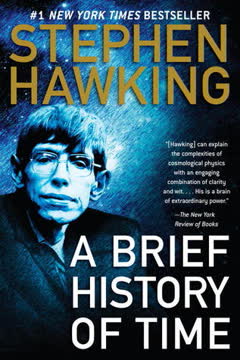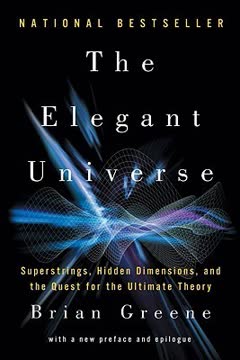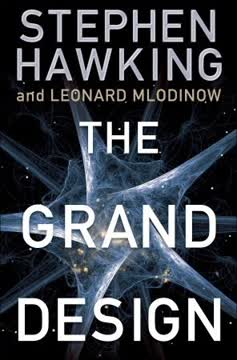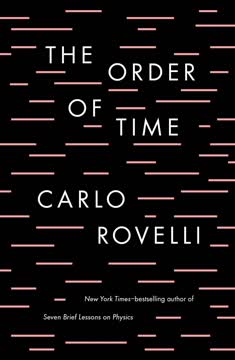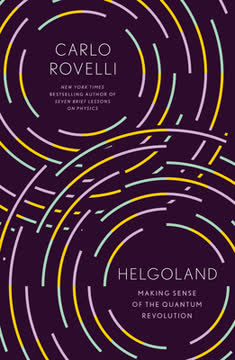Puntos clave
1. La teoría de la relatividad general de Einstein revolucionó nuestra comprensión del espacio, el tiempo y la gravedad
Einstein escribió una ecuación que dice que R es equivalente a la energía de la materia. Es decir: el espacio se curva donde hay materia. Eso es todo. La ecuación cabe en media línea, y no hay nada más.
La gravedad como espacio-tiempo curvado. La innovadora idea de Einstein fue que la gravedad no es una fuerza, sino la curvatura del propio espacio-tiempo. Este elegante concepto explica fenómenos como:
- Órbitas planetarias: Los planetas se mueven en trayectorias elípticas alrededor del sol porque siguen la curvatura natural del espacio-tiempo creada por la masa del sol.
- Desviación de la luz: Objetos masivos como las estrellas pueden desviar los rayos de luz que pasan cerca de ellos, un efecto observado durante los eclipses solares.
- Dilatación del tiempo: El tiempo pasa más lentamente en campos gravitacionales más fuertes, un fenómeno confirmado por relojes atómicos precisos a diferentes altitudes.
Predicciones y confirmaciones. La relatividad general hizo varias predicciones sorprendentes que han sido verificadas:
- Agujeros negros: Regiones del espacio-tiempo donde la gravedad es tan intensa que nada, ni siquiera la luz, puede escapar.
- Ondas gravitacionales: Ondulaciones en el espacio-tiempo causadas por objetos masivos en aceleración, detectadas por primera vez en 2015.
- Universo en expansión: Las ecuaciones de la teoría llevaron naturalmente al concepto de un universo en expansión, confirmado posteriormente por observaciones.
2. La mecánica cuántica desveló la extraña y probabilística naturaleza del mundo subatómico
Heisenberg imaginó que los electrones no siempre existen. Solo existen cuando alguien o algo los observa, o mejor, cuando están interactuando con algo más.
Dualidad onda-partícula. La mecánica cuántica reveló que entidades subatómicas como electrones y fotones pueden comportarse tanto como partículas como ondas, dependiendo de cómo se observen. Esto llevó a conceptos contraintuitivos como:
- Principio de incertidumbre: Es imposible conocer simultáneamente la posición exacta y el momento de una partícula.
- Superposición: Las partículas pueden existir en múltiples estados simultáneamente hasta que se observan.
- Túnel cuántico: Las partículas pueden atravesar barreras que la física clásica dice que no deberían poder atravesar.
Naturaleza probabilística. A diferencia de la física clásica, la mecánica cuántica trata con probabilidades en lugar de certezas:
- Función de onda: Describe todos los estados posibles de un sistema cuántico.
- Colapso de la función de onda: Al medir, el sistema "elige" uno de los estados posibles.
- Entrelaçamento: Las partículas pueden volverse "entrelazadas", con el estado de una afectando instantáneamente a la otra, independientemente de la distancia.
3. El cosmos: de una Tierra plana a un universo en expansión con miles de millones de galaxias
El universo comenzó como una pequeña bola y luego explotó hasta alcanzar sus dimensiones cósmicas actuales. Esta es nuestra imagen actual del universo, en la escala más grande que conocemos.
Cosmología en evolución. Nuestra comprensión del universo se ha expandido dramáticamente con el tiempo:
- Tierra plana con el cielo arriba.
- Tierra esférica en el centro del cosmos.
- Sistema solar heliocéntrico.
- Vía Láctea como una de muchas galaxias.
- Universo en expansión originado en el Big Bang.
Modelo actual. El modelo cosmológico moderno incluye:
- Big Bang: El universo comenzó como un estado extremadamente caliente y denso hace unos 13.8 mil millones de años.
- Inflación cósmica: Un período de rápida expansión en el universo temprano.
- Materia oscura y energía oscura: Componentes misteriosos que constituyen la mayor parte de la masa y energía del universo.
- Fondo cósmico de microondas: Radiación residual del universo temprano, proporcionando evidencia del Big Bang.
4. Partículas elementales: los bloques de construcción de toda la materia y energía
Todo lo que tocamos está hecho de electrones y de estos quarks.
Modelo Estándar. La teoría actual de la física de partículas describe las partículas y fuerzas fundamentales:
Partículas:
- Quarks: Seis tipos, se combinan para formar protones y neutrones.
- Leptones: Incluyen electrones y neutrinos.
- Bosones: Partículas portadoras de fuerza como fotones y gluones.
Fuerzas:
- Fuerza nuclear fuerte: Une los quarks.
- Fuerza nuclear débil: Responsable de la desintegración radiactiva.
- Fuerza electromagnética: Interacciones entre partículas cargadas.
- Gravedad: Aún no incorporada en el Modelo Estándar.
Teoría cuántica de campos. Las partículas se ven como excitaciones de campos cuánticos subyacentes que impregnan todo el espacio. Este marco ayuda a explicar fenómenos como:
- Partículas virtuales: Partículas fugaces que aparecen y desaparecen.
- Pares partícula-antipartícula: Creación y aniquilación espontánea de materia y antimateria.
5. Gravedad cuántica: la búsqueda continua para unir la relatividad general y la mecánica cuántica
La gravedad cuántica de bucles es un esfuerzo por combinar la relatividad general y la mecánica cuántica. Es un intento cauteloso porque utiliza solo hipótesis ya contenidas en estas teorías, reescritas adecuadamente para hacerlas compatibles.
El problema de la incompatibilidad. La relatividad general y la mecánica cuántica, aunque ambas son muy exitosas en sus dominios, son fundamentalmente incompatibles:
- Relatividad general: Describe la gravedad como una curvatura suave y continua del espacio-tiempo.
- Mecánica cuántica: Describe el mundo en términos de cuantos discretos y probabilidad.
Enfoques para la gravedad cuántica:
- Teoría de cuerdas: Propone que las partículas fundamentales son en realidad pequeñas cuerdas vibrantes en múltiples dimensiones.
- Gravedad cuántica de bucles: Sugiere que el espacio mismo está cuantizado en unidades discretas llamadas "bucles".
- Teoría de conjuntos causales: Modela el espacio-tiempo como un conjunto discreto de eventos con relaciones causales.
Desafíos e implicaciones. Desarrollar una teoría de la gravedad cuántica podría:
- Explicar la naturaleza de las singularidades de los agujeros negros.
- Proporcionar ideas sobre el origen del universo.
- Unificar todas las fuerzas fundamentales en un solo marco.
6. La naturaleza del tiempo: ¿ilusión o realidad?
Las personas como nosotros, que creemos en la física, sabemos que la distinción entre pasado, presente y futuro no es más que una ilusión persistente y obstinada.
El tiempo en la física vs. la experiencia humana. Mientras percibimos el tiempo como fluyendo del pasado al futuro, la física presenta una imagen diferente:
- Universo bloque: En la relatividad, pasado, presente y futuro existen simultáneamente.
- No hay un "ahora" universal: El concepto de eventos simultáneos se descompone en la relatividad especial.
- Reversibilidad: Muchas leyes fundamentales de la física son simétricas en el tiempo.
Emergencia de la flecha del tiempo. El aparente flujo del tiempo puede surgir de:
- Termodinámica: El aumento de la entropía da una dirección al tiempo.
- Mecánica cuántica: La medición y la decoherencia crean una aparente irreversibilidad.
- Cosmología: La expansión del universo proporciona una dirección temporal cósmica.
Preguntas abiertas:
- ¿Qué da lugar a nuestra experiencia subjetiva del tiempo?
- ¿Existe una diferencia fundamental entre pasado y futuro a nivel cuántico?
- ¿Cómo emerge el tiempo en las teorías de la gravedad cuántica?
7. Conciencia y libre albedrío: reconciliando la experiencia humana con las leyes de la física
No hay un 'yo' y 'las neuronas en mi cerebro'. Son la misma cosa. Un individuo es un proceso: complejo, estrechamente integrado.
El problema difícil de la conciencia. ¿Cómo surge la experiencia subjetiva de los procesos físicos en el cerebro?
- Teoría de la Información Integrada: Propone que la conciencia es una propiedad fundamental de ciertos sistemas de procesamiento de información.
- Teoría del Espacio de Trabajo Global: Sugiere que la conciencia surge de la difusión de información a través del cerebro.
Libre albedrío en un universo determinista. Reconciliando nuestro sentido de libre albedrío con las leyes deterministas de la física:
- Compatibilismo: El libre albedrío es compatible con el determinismo si nuestras acciones provienen de nuestras propias motivaciones y deseos.
- Libre albedrío libertario: Propone que la indeterminación cuántica permite una verdadera aleatoriedad en la toma de decisiones.
Implicaciones y reflexiones:
- Nuestras decisiones son el resultado de procesos neuronales complejos, no de un "yo" separado.
- La conciencia y el libre albedrío pueden ser propiedades emergentes de sistemas altamente complejos.
- Comprender estos fenómenos podría tener profundas implicaciones para la ética, la ley y nuestro sentido del yo.
Última actualización:
FAQ
What's "Seven Brief Lessons on Physics" about?
- Overview of Modern Physics: "Seven Brief Lessons on Physics" by Carlo Rovelli provides a concise overview of the most significant developments in physics during the twentieth century.
- Seven Key Topics: The book is structured around seven lessons, each focusing on a fundamental aspect of modern physics, such as relativity, quantum mechanics, and the architecture of the cosmos.
- Accessible to All: It is written for readers with little to no background in science, aiming to make complex ideas comprehensible and engaging.
- Philosophical Insights: Beyond scientific concepts, the book also explores the philosophical implications of these discoveries on our understanding of reality and ourselves.
Why should I read "Seven Brief Lessons on Physics"?
- Simplifies Complex Concepts: Rovelli distills complex scientific theories into digestible lessons, making it an excellent introduction to modern physics.
- Broadens Understanding: The book offers insights into how the universe works, enhancing your appreciation of the natural world.
- Philosophical Reflection: It encourages readers to reflect on the philosophical questions raised by scientific discoveries, such as the nature of time and reality.
- Cultural Impact: As an international bestseller, it has been praised for its poetic and accessible approach to science, making it a cultural touchstone for understanding physics.
What are the key takeaways of "Seven Brief Lessons on Physics"?
- Relativity and Space-Time: Einstein's theory of general relativity revolutionized our understanding of gravity, showing that space and time are interconnected and dynamic.
- Quantum Mechanics: The book explains the probabilistic nature of quantum mechanics, where particles exist in states of probability rather than certainty.
- Cosmic Architecture: It describes the vast and complex structure of the universe, from galaxies to the potential existence of multiple universes.
- Human Perspective: Rovelli emphasizes that our understanding of physics also reshapes our understanding of ourselves and our place in the universe.
What are the best quotes from "Seven Brief Lessons on Physics" and what do they mean?
- "The most beautiful of theories": This refers to Einstein's general theory of relativity, highlighting its elegance and profound impact on our understanding of gravity and the cosmos.
- "Reality is not as it appears": This quote underscores the book's theme that scientific discoveries often reveal a world far different from our everyday perceptions.
- "We are made of the same stardust": This poetic expression emphasizes the interconnectedness of all matter in the universe, including humans, reinforcing the idea that we are part of a larger cosmic story.
- "The flow of time is an illusion": This challenges our intuitive understanding of time, suggesting that time may not be a fundamental aspect of reality as traditionally thought.
How does Carlo Rovelli explain Einstein's theory of relativity in "Seven Brief Lessons on Physics"?
- Space and Gravity: Rovelli explains that Einstein's theory shows gravity is not a force but a curvature of space-time caused by mass.
- Time Dilation: The theory predicts that time passes at different rates depending on the gravitational field, leading to phenomena like time dilation.
- Simple Equations: Rovelli highlights the simplicity and elegance of Einstein's equations, which describe how matter and energy influence the curvature of space-time.
- Impact on Physics: The theory of relativity has profound implications for our understanding of the universe, influencing everything from the motion of planets to the behavior of light.
What is quantum mechanics according to "Seven Brief Lessons on Physics"?
- Probabilistic Nature: Quantum mechanics describes the behavior of particles at the smallest scales, where outcomes are probabilistic rather than deterministic.
- Wave-Particle Duality: Particles like electrons exhibit both wave-like and particle-like properties, depending on how they are observed.
- Quantum Entanglement: Rovelli discusses phenomena like entanglement, where particles become interconnected in ways that defy classical understanding.
- Philosophical Implications: The theory challenges traditional notions of reality, suggesting that observation plays a crucial role in determining the state of a system.
How does "Seven Brief Lessons on Physics" describe the architecture of the cosmos?
- Expanding Universe: The book explains that the universe is expanding, a discovery that has reshaped our understanding of cosmic history.
- Galaxies and Stars: Rovelli describes the vast number of galaxies, each containing billions of stars, highlighting the scale and complexity of the cosmos.
- Curved Space: The universe is not flat but curved, with space-time being influenced by the mass and energy it contains.
- Big Bang and Beyond: The book touches on the origins of the universe with the Big Bang and speculates on the possibility of other universes.
What does Carlo Rovelli say about particles in "Seven Brief Lessons on Physics"?
- Elementary Particles: Rovelli explains that everything is made of a few types of elementary particles, such as quarks and electrons.
- Quantum Fields: These particles are excitations of underlying quantum fields, which are dynamic and constantly fluctuating.
- Standard Model: The book discusses the Standard Model of particle physics, which describes the fundamental forces and particles but also highlights its limitations.
- Dark Matter: Rovelli mentions the mystery of dark matter, which is not accounted for by the Standard Model but is essential for understanding the universe's structure.
What is loop quantum gravity as explained in "Seven Brief Lessons on Physics"?
- Combining Theories: Loop quantum gravity is an attempt to reconcile general relativity and quantum mechanics into a single coherent framework.
- Grains of Space: The theory suggests that space is not continuous but made up of discrete 'atoms' or 'grains' of space.
- No Absolute Time: It proposes that time is not a fundamental aspect of reality but emerges from the interactions of these space quanta.
- Experimental Challenges: While promising, the theory is still largely theoretical, with ongoing efforts to find experimental evidence.
How does "Seven Brief Lessons on Physics" address the concept of time?
- Time and Heat: Rovelli links the flow of time to thermodynamics, suggesting that time's arrow is related to the increase of entropy.
- Illusion of Flow: The book argues that the flow of time is an emergent phenomenon, not a fundamental aspect of reality.
- Relativity of Time: Time is not universal but relative, varying with speed and gravity, as shown by Einstein's theories.
- Philosophical Questions: Rovelli explores the philosophical implications of these ideas, questioning our intuitive understanding of past, present, and future.
What philosophical insights does Carlo Rovelli offer in "Seven Brief Lessons on Physics"?
- Interconnectedness: Rovelli emphasizes the interconnectedness of all things, suggesting that our understanding of the universe also informs our understanding of ourselves.
- Nature of Reality: The book challenges traditional notions of reality, proposing that what we perceive is only a small part of a much larger and more complex whole.
- Human Perspective: Rovelli reflects on the human place in the universe, suggesting that our knowledge and consciousness are part of the natural world.
- Curiosity and Knowledge: He celebrates human curiosity and the pursuit of knowledge as fundamental aspects of our nature, driving us to explore and understand the cosmos.
How does "Seven Brief Lessons on Physics" conclude on the topic of human existence?
- Part of the Universe: Rovelli concludes that humans are an integral part of the universe, made of the same elements and subject to the same laws as everything else.
- Ephemeral Nature: He reflects on the ephemeral nature of human life, suggesting that our awareness of mortality gives life its value.
- Curiosity and Exploration: The book celebrates human curiosity and the drive to explore, which have led to our understanding of the universe.
- Home in Nature: Rovelli emphasizes that nature is our home, and understanding it helps us understand ourselves and our place in the cosmos.
Reseñas
Siete breves lecciones de física ofrece una visión concisa y poética de conceptos complejos de la física para el público en general. Los lectores aprecian la elegante escritura de Rovelli y su capacidad para explicar ideas difíciles, aunque algunos la encuentran demasiado simplificada. El libro abarca temas como la relatividad, la mecánica cuántica y la cosmología en breves capítulos. Muchos elogian su accesibilidad y estilo lírico, mientras que otros desean mayor profundidad. En general, se considera una hermosa y provocadora introducción a la física moderna que despierta la curiosidad, aunque no proporcione explicaciones exhaustivas.
Similar Books


